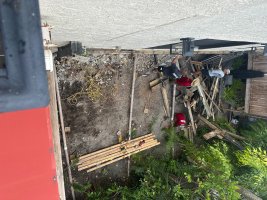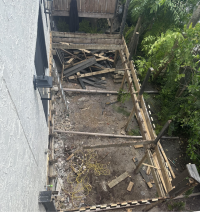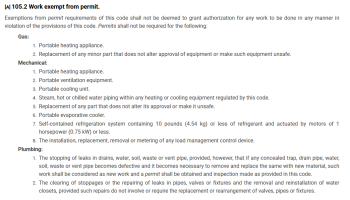Thank you. I'm just looking to find the specific verbiage of the deck requiring a permit I would think is found from
here but I cannot find it. In this case, unit owner responsibility. Wasn't run by city.
@BN4537 thank you, I think.
Would these photos satisfy those conditions?
Sorry for the lack of detail in my response, in my time zone I was just about to clock out and leave, and my account is on my work computer.
The code basically starts out in 105.1 that
everything needs a permit. It then lists a few exceptions, like 105.2.2, that
don't require a permit. If it's not on the list that doesn't require a permit, then it needs a permit.
It appears from the pictures that the posts, beam, and joists were all removed, and presumably replaced. Where the code begins to talk about structural members such as beams and load bearing supports, I would say that definitely applies to the posts being removed/replaced, and the front beam of the deck that the posts were supporting. Either of those items being removed or replaced would require a building permit. The odds are high that the original beam is undersized, and that it's connection to the post looks to rely on bolting instead of full bearing (actually sitting on the post or notched into the post where the beam is actually sitting directly on wood), which is completely wrong. Posts may be undersized also. If they just "put it back the way it was", they will be tearing it apart and starting over if a competent inspector gets involved.
I would also stretch it to mean that if any of the joists that run 16" on center are replaced, a permit would also be required, but that is an interpretation that is up to the local building official. Even if that is their interpretation, replacing a joist or two like-for-like would likely be better handled as don't-ask-don't-tell because it is not worth the inspector's time.
Deck collapses kill more people annually than all of the other varieties of framing collapses combined. This fact, combined with the fact that lumber is not as strong as it used to be because we continue to accelerate the growing cycle of the trees, which make the growth rings farther apart and weakens the lumber, so the same size lumber may not span far enough to go back like-for-like.
You really will need to talk to the local building department for concrete answers - I am an inspector, and I do have a decent grasp on the model code that the Florida Code is based on, but if they do things weird locally, I have no way of knowing that from my lofty perch behind my keyboard here in Kansas. That is why I keep putting a disclaimer in my answers - just because the rest of the nation or state does it this way, doesn't mean they do it there.






